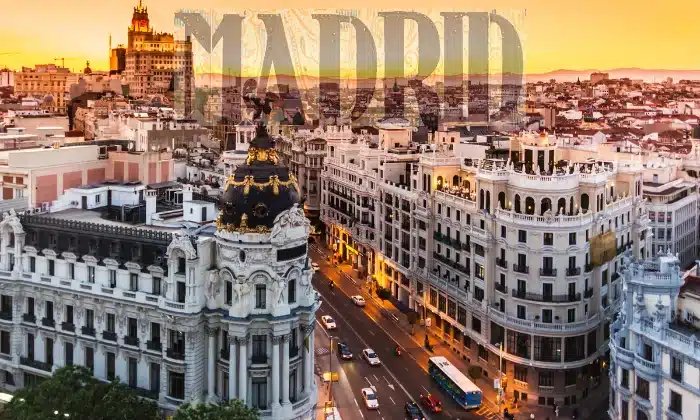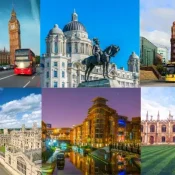
Madrid. Exploring Architectural Gems
Madrid. Exploring Architectural Gems. Visit best tourist places such as Edificio España,Plaza Mayor, Royal Palace,Almudena Cathedral, Edificio España,CaixaForum,Catedral de la Almudena, Plaza de la Villa, Las Descalzas Reales and Iglesia de San Jerónimo el Real.
Madrid. Exploring the Architectural Marvels of This Historic City
Madrid holds a treasure trove of architectural works spanning centuries, each with its own intriguing history woven into the city’s fabric. From opulent palaces fit for royalty to whimsical places of worship adorned with ornate details, Madrid never ceases to astound visitors with its vast array of structures. This article provides an overview of some of Madrid’s most notable designs, guiding readers to uncover the stories behind each landmark.
Centuries of innovative design have left Madrid filled with buildings renowned for their artistic ingenuity. Situated right in the heart of it all is the Plaza Mayor, a plaza that has stood as the city’s lively center for over four hundred years. Surrounding this hub is a cornucopia of styles, from Moorish influences to lavish Baroque designs. Nearby also lies the Royal Palace, an epitome of luxury and an entertaining reminder of Spain’s regal past. Beyond these central attractions, entire districts showcase architectural periods through seminal works that defined their eras.
Madrid’s architectural heritage stems from its position at the crossroads of cultures. Successive rulers from diverse backgrounds have all contributed to its profusion of styles. Under Moorish rule in the Middle Ages, remnants of their ornamental flair still endure. Later, the Renaissance brought humanism and rational order in balanced designs like the imposing Almudena Cathedral. The lavish Baroque movement saw indulgent creations like the Buen Retiro park take form. Ornate Churrigueresque also emerged, most exemplified at the phenomenal San Francisco El Grande church.
In modern times, Madrid continued innovating with daring structures. The skyscraping Edificio España tower stands tall from the last century. Near Reina Sofía, the repurposed CaixaForum stuns with its interior ingenuity. Contemporary additions in business districts and parks reflect today’s design influences. Beyond the city, day trips offer even more architectural treasures from other eras. Medieval Toledo, El Escorial monastery, and summer palaces are some notable alternatives within reach.
This article will examine an array of Madrid’s most striking architectural works. By exploring their ornate details, varied styles, and places in history, readers can better appreciate the diverse creativity that shapes this still-evolving city. Its architectural landscape is a living chronicle of the shifts that have transformed both its urban fabric and the nation at large through the centuries.
The Vibrant Heart and Opulent Soul of Madrid
At the lively heart of Madrid lies the Plaza Mayor, a stunning plaza that has embodied the city’s pulse for over four centuries. Originating in the 17th century, its distinctive enclosed shape and uniform stone buildings make it one of Spain’s finest central plazas. Once a bustling hub for commerce and royal pronouncements, the Plaza Mayor maintains its role as a gathering place where locals and visitors alike can appreciate street performers or merely take in the architectural scenery. Its ground is carved with the shields of Spain’s various regions, representing the nation’s cultural diversity even in such simple stonework. Towering above one end of the plaza, and arguably more extravagant still, stands the epitome of royal opulence – the Madrid Royal Palace.
Continuing a tradition of stately homes on this site dating back to the 9th century, the current Royal Palace was built in the early 18th century. Designed in a restrained Baroque style, its elegant facades conceal a veritable treasure trove of art and history within. Marbled halls, gilded salons, and lavish throne rooms testify to ancient empires and Spain’s place amongst Europe’s most extraordinary powers.
Armour worn by conquistadors and priceless tapestries depicting royal victories hangs alongside works by masters like Goya and Velázquez. In perhaps its most impressive hall, a forest of crystal pendants adorn the sumptuous ceiling of the Throne Room, forming a spectacular dramatic baroque chandelier illuminating generations of monarchs.
Despite its grandeur, the palace is no mere museum piece but remains the symbolically home of modern Spain’s royal family. When not carrying out their duties, King Felipe and Queen Letizia reside within its stately confines alongside their daughters. Yet its grounds are open to the public, granting a privileged glimpse into a lifestyle few will ever experience.
In addition to the splendors gathered inside its walls, expansive gardens offer a scenic escape from the urban bustle right in the city center. Their allées are lined with fountains, statues, and pools punctuated by fragrant flowers – a verdant sanctuary for the mind amidst storied surroundings. Together, the plaza and palace define Madrid’s proud royal and cultural essence for all to enjoy.
Gems of the Historic Downtown
Just north of the Plaza Mayor lies Madrid’s historic downtown core, harboring several iconic structures renowned for architectural and cultural significance. Chief amongst these is the Puerta del Sol, a sun-shaped glass and iron canopy sheltering the bustling thoroughfare below.
Considered the factual center of Spain, with Kilometer Zero marking all significant road distances, it has been the nexus of the city’s everyday life and communications for centuries.
Nearby also sits the Catedral de la Almudena, an imposing neo-Gothic cathedral erected after centuries-long calls to construct a grand house of worship for the Spanish capital. Its sober sandstone facade presents towering spires that add to the imposing skyline of the Centro district.
A short stroll away lies another renowned plaza, Plaza de la Villa. At its centre proudly stands Madrid’s ancient city hall, a stellar example of the Spanish Plateresque style adorned with lavish carvings. It maintains a ceremonial role as the official seat of Madrid’s government.
The uniform apartments encircling the plaza date back to the 16th century, accounting for an admirably preserved example of Renaissance urban planning. Their arched entryways now shelter chic boutiques and restaurants much as they did centuries past.
Traversing these postcard-worthy streets transports visitors to a bygone Madrid, where one expects to find horse carriages clacking past golden facades instead of today’s bustle.
Venturing further leads to the captivating Convent of Las Descalzas Reales. Behind an unassuming granite front, its austere Clausura cloister brims with hidden treasures. Intricate frescoes and sculptures abound, bespeaking the nuns’ former role as caretakers for the royal family. Now fully restored, it offers a unique glimpse into cloistered life.
A short walk west, the lavish Iglesia de San Jerónimo el Real also stands amid manicured gardens, indicative of its Augustinian origins. Its eclectic architecture combines Renaissance, Gothic, and Mudéjar traditions into a harmonious whole that transports worshippers to another age. Together, these landmarks interwoven at Madrid’s bustling heart impart a sense of history with each discovery around their storied streets.




